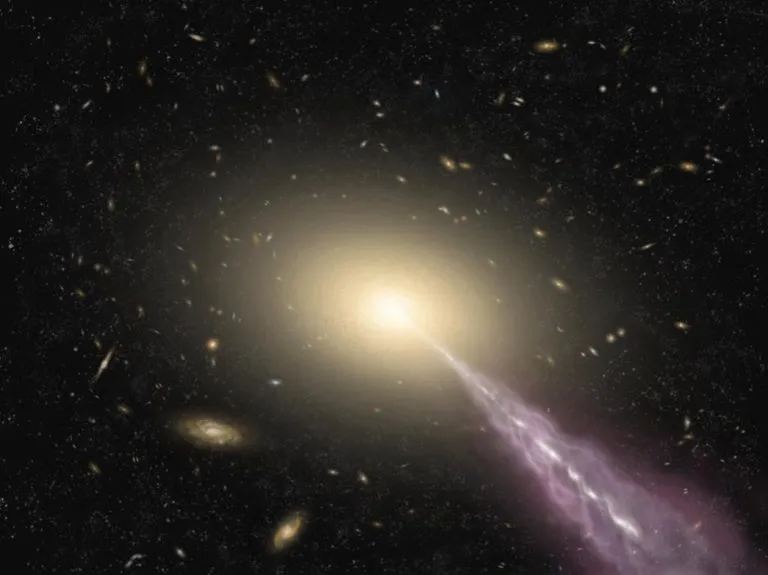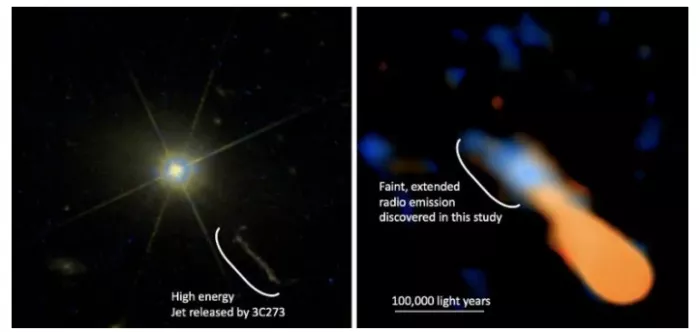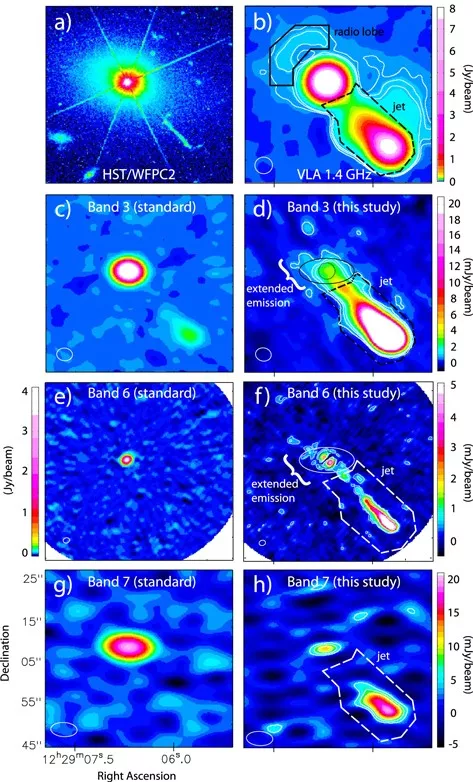Astronomers have just discovered an unknown structure hidden in the shadow of a galaxy They achieved this goal by expanding the dynamic range of the Atacama large millimeter / sub millimeter wave array (ALMA), which is currently the largest astronomical project to detect weak radio emissions.

This weak radio emission, regardless of the radio frequency, has a constant brightness and extends tens of thousands of light years in the main star system of quasar 3c273. It is a symbolic cosmic "beacon". The discovery may help uncover the secrets of galaxy evolution and star formation.
Due to the realization of high imaging dynamic range, a team of astronomers in Japan discovered for the first time a weak radio emission covering a huge galaxy with an energy black hole in the center. The radio emission is released by the gas directly produced by the central black hole. The team hopes to understand how a black hole interacts with its host galaxy by applying the same technique to other quasars.
3c273 is a quasar located 2.4 billion light-years away from the earth. Quasar is the core of a galaxy. It is believed that there is a huge black hole in its center, which devours the surrounding material and emits huge radiation. Contrary to its bland name, 3c273 is the first quasar ever discovered, the brightest and best studied. It is one of the most frequently observed light sources by telescopes because it can be used as a standard position in the sky: in other words, 3c273 is a radio "beacon".

When you see the lights of a car, the dazzling brightness makes it difficult for you to see the surrounding dark environment. The same thing happens with telescopes when you look at bright objects. Dynamic range refers to the contrast between the brightest and darkest tones in an image. You need a high dynamic range to show both bright and dark parts of the telescope in a single shot. Alma can often reach an imaging dynamic range of about 100, but digital cameras on the market usually have several thousand dynamic ranges. Radio telescopes are not good at seeing objects with obvious contrast.
3c273, as the most famous quasar, has been known for decades, but people mainly focus on its bright central core, where most radio waves come from. However, much less is known about the host galaxy itself, because the combination of dim and diffuse galaxies with 3c273 nuclei requires such a high dynamic range to detect. The research team used a technology called self calibration to reduce the leakage of radio waves from 3c273 to the galaxy. This technology uses 3c273 itself to correct the impact of earth's atmospheric fluctuations on the telescope system. Their imaging dynamic range reached 85000, which is Alma's record of extragalactic objects.
Due to the high imaging dynamic range, the research team found that the weak radio emission extended to tens of thousands of light-years of 3c273 host galaxy. The radio emission around quasars usually indicates synchrotron radiation, which comes from high-energy events, such as the explosion of star formation or the ultrafast jet from the central nucleus. There is also a synchrotron radiation jet in 3c273.

A basic feature of synchrotron radiation is that its brightness will change with the change of frequency, but the weak radio radiation found by the research team has a constant brightness at any frequency. After considering other mechanisms, the team found that this weak and extended radio emission came from the hydrogen directly excited by the 3C 273 nucleus in the galaxy. This is the first time that radio waves from this mechanism have been found to extend tens of thousands of light-years in the host galaxy of quasars. Astronomers have ignored this phenomenon of this iconic cosmic "beacon" for decades.
So why is this discovery so important? In galactic astronomy, whether the energy from quasar nuclei is strong enough to deprive galaxies of their ability to form stars has always been a big mystery. This weak radio emission may help solve this problem. Hydrogen is an important component in the creation of stars, but if such a strong light shines on it and causes the gas to be decomposed (ionized), stars cannot be born. To study whether this process occurs around quasars, astronomers used optical light from ionized gas. The problem with using optical light is that cosmic dust will absorb light on the way to the telescope, so it is difficult to know how much light the gas emits.
In addition, the mechanisms responsible for emitting optical light are complex, forcing astronomers to make many assumptions. The radio waves found in this study come from the same gas due to a simple process and are not absorbed by dust. The use of radio waves makes it easier to measure ionized gases produced by the nuclei of 3c273. In this study, astronomers found that at least 7% of the light from 3c273 was absorbed by the gas in the host galaxy, and the ionized gas created reached 10-100 billion times the mass of the sun. However, 3c273 has a large amount of gas before star formation, so on the whole, it is not as strongly inhibited by nuclei as star formation.
"This discovery provides a new way to study the problems previously solved by optical observation," associate professor of Nippon Institute of technology, published in Astrophysical Journal 》Shinya Komugi, the lead author of the study on. "By applying the same techniques to other quasars, we hope to understand how a galaxy evolves through interaction with its central nucleus."